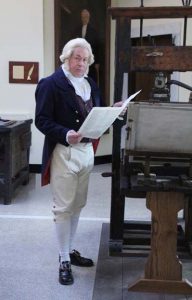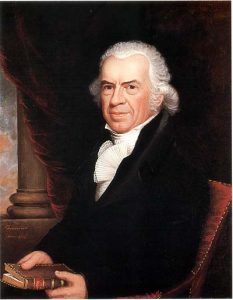by Gretta Cox Gorton
While school field trips normally consist of a chaotic litany of permission slips, long bus rides, and a brown bag lunch, fifth graders in Worcester’s public schools are having a revolutionary kind of learning experience.

Instead of students taking the usual trek to an historical site, such as Old Sturbridge Village (thirty minutes southwest of the city), to talk to reenactors stirring vats of maple syrup or fleecing wool, the reenactor comes to them. Born out of a one-man play created by former American Antiquarian Society outreach director James D. Moran, actor Neil Gustafson brings the AAS’ founder, American printer, Revolutionary, and Worcesterite Isaiah Thomas to life in the dramatic program “Isaiah Thomas – Patriot Printer”.

Isaiah Thomas was born in Boston in 1749, and began his lifelong career as a publisher after his mother indentured him to a printer at age 7. He would go on to famously publish the politically antagonistic Massachusetts Spy, which consistently toed the line of attracting British suppression efforts in the infancy of the American Revolution. This tension culminated in the days just before the Battle of Concord, when Thomas fled Boston for Worcester, printing presses in tow (the property he left behind was destroyed). In Worcester, his career in the printed word flourished. Beyond continuing to print and publish newspapers and books, and eventually writing a history of publishing himself, he established the first national historical society, the American Society of Antiquaries (now the American Antiquarian Society), in 1812. Well known in the publishing world, and locally as a significant historical figure, Thomas is one of the lesser known American Revolutionaries, but has nonetheless had an immense impact in the creation and dissemination of early American political values.
The program which brings 1812 Thomas into the 21st century is currently sponsored by the American Antiquarian Society and the Worcester Telegram and Gazette, and has been engaging historically minded audiences in Central Massachusetts on and off for over two decades. And while any historical society, senior center, or museum can book “Thomas” for a performance, since the Society’s bicentennial in 2012, the program has gained a very special and specific audience – Worcester’s fifth graders.
Through partnerships with the Worcester Public Schools, CultureLEAP (which offers intensive curriculum based cultural experiences to all students in a given grade), and an interactive online curriculum aid to assist educators in connecting classroom materials to Thomas’ visit, students get the rare opportunity to put down their Chromebooks and interact with a figure from the history they’re just beginning to learn about in earnest.
Dressed in 18th century garb, “Thomas” tells his life story, and introduces students to original documents from his heyday, providing direct and animate access to both local and national history. He proudly tells them about his achievements, like publicly reading the newly minted Declaration of Independence on the steps of Worcester’s City Hall, the first time it had ever been read aloud in New England.
He answers questions, in and out of character, like whether or not he had any pets, if he can take off his wig (to which he kindly proffers “you never ask a gentleman to take off his wig in public”) and what it felt like to be separated from his mother at such a young age. Acting as a piece of “living” history, Gustafson’s character provides insight into Thomas’ personal life and experience living and working during a time of incredible political upheaval. The performance demonstrates not only how different life was in 1812 (“pets” were mostly farm or working animals) but also how similar experiences like struggling for a more just and equitable society are across space and time.
Artists like Gustafson are no stranger to working with public history and its curators. Archives and cultural heritage sites are known to invite artists into their reading rooms and outreach programs as collaborative partners to create contemporary paths for visitor engagement, something artists are uniquely positioned to do. No sound or video evidence exists to document Isaiah Thomas, for obvious technological reasons so we rely on artistic renderings to embody this lost element of the historical record. Art imitates life, and in the case of “Isaiah Thomas – Patriot Printer”, art successfully engages audiences in how we connect to our shared history, specifically the people who made it (or, at the very least, printed it).
Further Reading
Information about the program and how to book “Thomas”:
https://www.americanantiquarian.org/itprogram.htm
Worcester Telegram & Gazette article about the program:
https://www.telegram.com/article/20120314/NEWS/103149867/1011
A short video of Gustafson as Isaiah Thomas:
https://www.youtube.com/watch?v=nqZE83Ru8TY&t=1s
